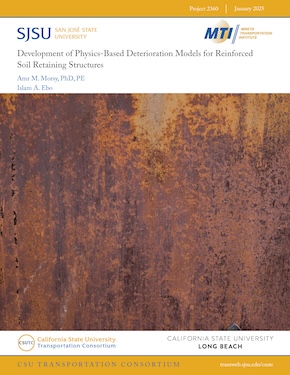- 408-924-7560
- mineta-institute@sjsu.edu
- Donate
Development of Physics-Based Deterioration Models for Reinforced Soil Retaining Structures
Reinforced soil walls are key earth retention features in the transportation infrastructure. They are used to support and retain soil in a wide variety of crucial structures, such as highways, bridges, and railways, to ensure stability. They also provide solutions for constructing embankments and slopes in constrained spaces, allowing for efficient land use and improved infrastructure planning. This study used advanced numerical modeling to improve the understanding of the behavior and long-term performance of the aging reinforced soil walls from the 1970s for asset management purposes. An asset-scale model was created to simulate the effects of weather on these walls. The model included a system to track how moisture-driven corrosion affects wall stability and performance over time. The model outputs provide implications on the wall progressive deterioration over time and estimates for the wall remaining service life. Unlike newer wall generations constructed with strict specifications that limit fill corrosivity, early wall generations may maintain high levels of moisture for prolonged periods that can significantly increase corrosion rates. Accordingly, it is recommended that fill moisture monitoring be added to asset management measures for early generation walls that could have been constructed with highly corrosive or poorly drainable fills. The results of this study indicate that even though corrosion rates vary with changes in fill moisture, the overall loss in reinforcement thickness happens at a steady rate, showing a linear relationship between cumulative corrosion and time. The results also indicate that 25% fluctuation in fill moisture has no to little effect on the cumulative corrosion, and that the average fill moisture can be used to predict an approximate long-term cumulative corrosion. Thus, it is recommended to use one year of seasonal climate data for a specific location to estimate the annual variation in fill moisture. This can predict the yearly corrosion of reinforcements, which can then be multiplied by the number of service years to estimate long-term cumulative corrosion. Finally, an asset-scale performance model based on performance-requirement failure framework was developed using the outputs of the asset-scale numerical model. These performance models can inform decisions about critical transportation infrastructure maintenance, repair, or replacement strategies, and optimizing resource allocation.
AMR M MORSY, PHD, PE
Dr. Amr Morsy is a professional civil engineer with experience in both academia and industry. His research focuses on geotechnical engineering, transportation geotechnics, environmental geotechnics, and climate adaptation. He obtained his B.Eng and M.Sc. degrees in civil engineering from Cairo University in 2011 and 2013 respectively and obtained his PhD degree in civil engineering from The University of Texas at Austin in 2017. He worked as a postdoctoral fellow at The University of Texas at Austin in 2018 and as a practicing geotechnical engineer from 2018 to 2020. He later worked as a research associate at Loughborough University on the ACHILLES program grant from 2020 to 2022. He has been working as an assistant professor at California State University, Long Beach since 2022. As part of his academic experience, Dr. Morsy conducts research on geotechnical infrastructure deterioration and asset management, climate change impacts on geotechnical infrastructure, and geotechnical solutions for sustainable built environments. He has excelled in physical and numerical modeling of geotechnical and geoenvironmental engineering systems, and in infrastructure instrumentation and laboratory experimentation. He participated in research projects sponsored by the Transportation Research Board of the National Academies of Sciences, Engineering, and Medicine, the Engineering and Physical Sciences Research Council of the UK Research and Innovation, the US Federal Highway Administration, the Geosynthetic Institute, the Departments of Transportation of Texas and Indiana, and geosynthetic manufacturers. As part of his professional consulting experience, Dr. Morsy conducts rigorous analyses, designs, and forensic evaluations for a range of slopes, retaining walls, reinforced soil structures, deep excavations, bridge foundations, waste containment facilities, tailings dams, and embankment dams. He assisted expert witnesses in cases involving collapse and poor performance of earth retaining structures. He provided solutions to geotechnical problems in a number of environmental remediation projects involving cleanup of superfund sites. He conducted multi-phase flow analyses for several infrastructure features including earthworks, embankment dams, and cover systems. Some of the consulting projects he participated in served the US Environmental Protection Agency, New York State Department of Environmental Conservation, New York State and Indiana Departments of Transportation, Tennessee Valley Authority, New Jersey Transit, and several multinational private and public corporates.
ISLAM A EBO
Islam Ahmed is a marine and geotechnical engineer with experience in both industry and academic research. He obtained his bachelor’s degree in civil engineering from Alexandria University in 2018 and is currently pursuing a master’s degree in geotechnical engineering at California State University, Long Beach. Islam has worked on a variety of large-scale civil and geotechnical engineering projects with a focus on infrastructure development, particularly in marine and coastal environments. His work involves using advanced engineering tools to ensure the structural stability and environmental sustainability of these projects. In his research role, Islam is focused on studying soil-structure interactions, coastal protection strategies, and the effects of environmental factors on marine infrastructure. He has developed strong skills in geotechnical analysis, project management, and field assessments, working closely with multidisciplinary teams to address engineering challenge.
-
Contact Us
San José State University One Washington Square, San Jose, CA 95192 Phone: 408-924-7560 Email: mineta-institute@sjsu.edu






